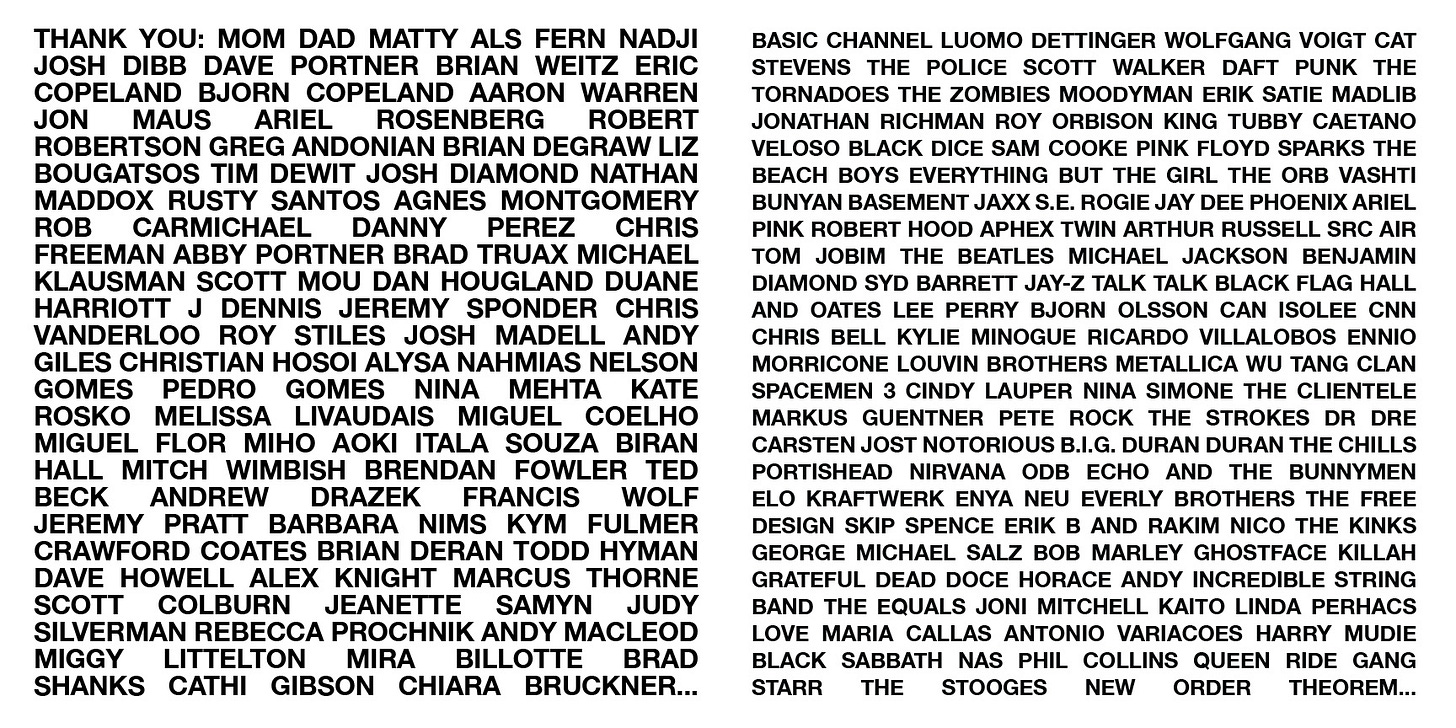Herb Sundays 146: Panda Bear
The inimitable Noah Lennox 20+ years into his incredible Panda Bear project. "these are songs to start a sunday peacefully...these tracks do inspire a kind of cozy solitude in a way i like"
Herb Sundays 146: Panda Bear
Playlist: Apple Music, Spotify
Art by Michael Cina
"these are songs to start a sunday peacefully...not much of a subscriber to guilty pleasures but these tracks do inspire a kind of cozy solitude in a way i like"
-Panda Bear for Herb Sundays
From the bio: Two decades since debuting as the masked-and-nicknamed drummer and vocalist of Animal Collective, Noah Lennox has led so many creative lives, navigated so many different styles, and been part of so many beloved recordings, that it can be easy to overlook just how consistent his creative vision has remained. From landmark solo albums like 2007’s Person Pitch and 2015’s Panda Bear Meets the Grim Reaper, to breakthroughs with Animal Collective like 2004’s Sung Tongs and 2009’s Merriweather Post Pavilion…
[Regarding his new album: Sinister Grift (2025, Domino)]: Working in his Lisbon, Portugal home studio with Animal Collective bandmate Josh “Deakin” Dibb, Lennox transforms Panda Bear into something resembling an old-school rock ensemble, playing nearly all the instruments himself and inviting kindred spirits into the process such as Cindy Lee, Spirit of the Beehive’s Rivka Ravede, and—for the first time on a Panda Bear solo album—each of his Animal Collective bandmates.
I’ll avoid trying to write a thorough bio of Animal Collective as I’m sure some of my readership are experts, and I’ll likely trip and not recover (cue the imagined cretins in “Cemetry Gates”); in fact, I asked readers for suggestions on other ways into the group apart from their canonical albums, it remains daunting to consume it all for me at least.
The “beat” for each Herb Sundays usually doesn’t take shape mentally until a few days from thinking about it. I wasn’t sure what form it would find for Panda Bear’s Herb Sundays 146 as I feel like he so firmly belongs to the world already, but I dug in on what I always sort of secretly thought of the project, that it was one of the most significant electronic music projects of our time.
Indeed, what I like about Lennox’s music is that I have always seen it as a loop-based project in spirit. Luckily for him (and us), it wasn't categorized as electronic music, which would likely have limited its appeal, especially in the early 2000s. Person Pitch almost felt like DJ Shadow’s Entroducing… (1996) to me, not sonically, but as a display of force in that both records are like, “Look what you can do with a sampler.” If Shadow showed what you can do with meticulously sourced and placed samples, Panda Bear showed that you could be a one-man psych band without being a laptop lurker (pre #dawless mindset), which was de rigeur for electronic music acts of the time.
Indeed, as an artist, he touts simple processes and limited means. I looked at myraid forums from 2007 with goobers arguing about the gear choices. There’s a roguishness about it all, lots of Guitar Center-ready tools used for exquisite aims. When combing through the Panda Bear archives, I also realized the Daft Punk-ness of it all. I didn’t clock him as a superfan even after his appearance on 2013’s Random Access Memories. However, the friends-based aspect of the group is also very Panda-esque. Deakin even recounts that he and Lennox “first started putting music down to multitrack cassette in 1991. 32 years later and working in the same fashion, two friends alone in a room searching for sounds and feelings that move us…”
In the clip below from his Ion Pack podcast interview, he talks about working with the duo. It's recounting almost sounds like someone sharing their dream/nightmare about meeting your musical heroes who sort of just put you on the spot, you open your mouth to sing, and….nothing. Luckily for our protagonist, he nailed it, and instead of becoming a chopped-up afterthought of a sample, Lennox’s voice is truly in the lead; the robots do the grunt work beneath.
The enduring appeal of Lennox is, of course, the music and the raw assemblage of taste on display. And then there’s that voice, that big cathedral window of a sound. It’s a sonic trademark beyond compare, stacked and dusted, impenetrable to copies, the pan is already seasoned. The archetype of the rebellious choir boy with the mop of hair cuts a memorable psychic image, caught somewhere between the sacred and the profane but never nihilistic nor defeated. I texted Matthew Dear (fave Lennox track: “Boy’s Latin”), another Daft Punk acolyte, that Panda Bear was this week's guest, and he replied quickly, “Perfect blend of brains and creativity.”
Indeed, the often unspoken appeal of the project is its taste world, including the artwork, the mythos, and, indeed, the song titles themselves. Lennox, in a podcast, says he has an Apple Notes file of titles he carries around, which he pulls from in a pinch (as do I) and then lives with to see if they still work. For instance, the words “Sinister Grift” have been hanging around since last decade, but they have stuck to the wall and adhered to this body of work. The process may not be dissimilar to finding a loop in the sampler and letting it run while you pop out to make lunch, returning to see if it’s as extraordinary as you left it. This is something I always suspected Thomas Bangalter of doing in my fan fiction.
There’s a generosity of spirit to Lennox’s fandom that is magnetic and an elemental piece of the project’s goodwill. In fact, I was reminded of Lennox’s devotion by one of my favorite contemporary electronic musicians and my work colleague, Akeem Asani (on Lennox: “There’s a good chance Panda Bear is your favorite musician's favorite musician”), who records as Millia and is 1/3 of ambient/dub/techno heroes Purelink. He reminded me of the Rob Carmichael-designed liner notes from Person Pitch, which includes a heart-on-sleeve shoutout list not dissimilar to Daft Punk’s Respect To… section in the Homework (1997) liner notes or the song “Teachers.” It’s a boy’s bedroom wall (Christian Hosoi!) with taped-up 7” sleeves, a bootleg Marley poster, ripped-out photos from The Source and NME, and some battered 12” techno jackets for good measure.
That top row of German MF’ers, including Basic Channel, their Finnish acolyte Vladislav Delay (Luomo), and some Kompakt kings says it all. There’s Daft Punk in line two, and other loopheads Madlib, Jay Dee (how heads knew J Dilla), and Moodymann in the mix too.
It’s been an absolute joy delving back into Panda Bear, I was and have remained a fan, but I don’t know if my heart was ever entirely open to Animal Collective upon arrival, I think I was threatened by their success at the time, in that Ghostly was getting its footing but maybe (I thought) by not being tagged as “electronic” music, it gave them leverage most artists in the lane didn’t have. In retrospect, they were just extremely good. Sometimes, there are no tricks.
Lennox seems to be having fun at this stage of his career. Instead of retreating into solemnity and myth, he frequently appears as a guest on myriad projects he admires, from Daft Punk peers Braxe + Falcon, to Bullion (on Ghostly, thankfully), the equally enigmatic Dean Blunt, and more. There’s a “you can do it too” aspect to Lennox’s career, which started with the simplicity of chosen tools, the Boss SP-303 and its heirs, the Roland SP-555 (which appear like twin cobras in the video for “My Girls”). No gatekeeping to be found.

There are very endearing videos of young people playing Panda Bear covers in their rooms to support this claim. This Guardian piece warned me that it was “more than 17 years old,” which was kinda jarring, where Lennox expresses his love for the humble and already outmoded Boss SP-303 sampler. When asked what technology he wants, instead of a fancy synth like most would say, he suggests a better coffee maker.
TG: What's your favourite piece of technology? PB: The Boss SP-303 Sampler.
I was worried it was apocryphal, but this interview with
confirmed the story of how Person Pitch came to be.Did you record everything with a Boss Sp 303 (digital sampler)?
Yeah, two of them. That’s what I’ll be playing with tonight.
Your previous solo album was mostly acoustic. Do you think the 303 had a major impact on the direction of your song writing?
Totally, it fully dictated the style that I eventually developed. When I moved to Lisbon I didn’t take a whole lot. I couldn’t really take all my equipment with me on the plane, you know. Those things are pretty small. I managed to take those and they were all I really had to make music on. So I kind of feel like I was forced into figuring out ways into making songs that I thought were good on those things. And like with the looping functions, there is not a whole lot of memory on them, so the samples had to be pretty small. All sorts of things, yeah, it’s a very SP 303-heavy record. It’s as much a musician on the album as I am, if you know what I mean.
The record that gripped me hardest when revisiting the Panda Bear oeuvre was Tomboy (2011, Paw Tracks), his leap to the Korg M3 unfurling new neural pathways. you also remember how dubwise Panda Bear is from this mode.
For Tomboy, Lennox tossed out his Roland SP-303 samplers, what he affectionately calls his “songwriting buddies” – in favor of guitars. “I’d written so many songs [using] samplers and I was feeling like I was starting to write the same kind of song over and over,” he says. On Person Pitch, he’d “find nuggets of sound” and repeat them until melodies would form in his mind, usually over one drone note or chord.
Tomboy represents a step up in production quality, splitting the atom for his sound.
While he loved the compressed sound that the SP-303 gave samples, for Tomboy Lennox turned his attention to Korg’s M3 workstation module, a “white box with weird little faders and knobs” that usually has a keyboard attached. Keeping a “rudimentary input method style,” Lennox ran his guitar through the M3’s matrix of effects. He upgraded from the free version of Cubase he had used for Person Pitch to Ableton, though he admits he remains hardware and performance-oriented, thinking of the computer only as a “multi-track machine” and rarely using it for signal processing. “Basic” became Lennox’s mantra on Tomboy. “Is this basic enough?” he’d ask himself as he evaluated the work, insisting on being able to play all the songs live as he recorded.
Basic enough. We can keep reducing and reducing and reducing.
Bonus Beats:
New on Ghostly
Goya Gumbani’s jazz-rap opus Warlord Of The Weejuns “Is Hugely Impressive” says Clash Magazine.
New on drink sum wtr
Annahstasia announced her new album this week with “Villain” - just press play, i promise.









Tomboy's my favourite too.
One of my favourite things about electronic music in general is that, no matter how much I read about it, and no matter how many performances or videos I watch, and no matter how much I try to make it myself - I still have no idea how it's made!
This piece mentioned a number of samplers and techniques, but it may as well have been describing a wizard's grimoires as a means to an end - it's pure magic!
Love that he name drops Enya in the PP liner notes.